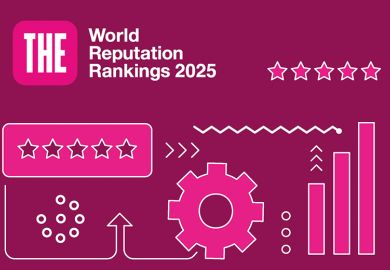Browse the full Young University Rankings 2017 results
The first edition of what was then known as the Times Higher Education 100 Under 50 ranking, back in 2012, featured on its cover an image of the first young shoots of an oak tree sprouting from an acorn.
This was, of course, a visual metaphor for the universities featured in the data analysis: those institutions under the age of 50 (very young in a sector where some of the established performers have many centuries of history) that were beginning to develop into strong and stable institutions with a long future ahead of them.
In many respects, the image could also have been a metaphor for the rankings themselves. What began five years ago as a modest, niche exercise, seeking to identify emerging stars of the global university world (the “likely future Harvards or Berkeleys”, as economist Andrew Oswald described them at the time), has grown into a much deeper, more comprehensive, more inclusive analysis – driven by the increasing demand for data and analysis on the performance and the strategies of institutions that have managed to develop into global powerhouses in an exceptionally short period of time.
So this 2017 edition has a series of additional data analyses.
The original “Under 50” ranking remains, but it has now expanded to include 200 institutions, up from 150 last year and 100 institutions previously. What we are now calling the THE Young University Rankings have the same methodology as in the past, with the same carefully balanced range of 13 performance metrics that make up the overall World University Rankings, but with careful re-weighting to better reflect the characteristics of younger universities.
The ranking also applies the same ruthless policy of including only those institutions aged 50 or under, which means that each year universities are eliminated from the list for no reason other than the fact that they have reached the age of 51.
But this year there’s more. First, we’re ranking subsets of the under‑50 institutions separately, covering different generations of the young universities. Our new “Generation X” table features 51 institutions founded between 1967 and 1985; a “Generation Y” table covers 71 institutions founded between 1986 and 1999; and our “Millennials” list covers 23 institutions founded since the turn of the century, from 2000 to today.
Perhaps the most significant development is the inclusion of a ranking of an entirely new age group for the first time – those institutions founded in what we describe as the “Golden Age” of higher education, from 1945 to 1966. This period after the Second World War saw an extraordinary expansion of higher education and a major increase in investment in university research.
National flagship institutions such as the Australian National University and Seoul National University were both born in 1946, and in the US this era saw several major additions to the University of California system, including UC Riverside (1954), San Diego (1960) and Irvine and Santa Cruz (both 1965). The early 1960s were also a landmark era in the UK, where the 1963 Robbins report heralded the birth of “plate glass” universities such as the University of East Anglia. The “Golden Age” top 100 uses the exact same methodology as the THE World University Rankings, so it is a simple filter of the 2016-17 World University Rankings.
Back in 2012, when the under-50 ranking was first published, the higher education expert Jamil Salmi pointed out the power of such data: the decision by a number of middle- and high-income countries to set up “excellence initiatives” in their “determination to attain drastic short-term improvement” for elite universities, combined with the creation of entirely new institutions in emerging economies, had seriously challenged the traditional notion that academic excellence required, like wine, “a long maturation period”.
THE is pleased to be able to provide the data to monitor the progress of such emerging institutions, and to provide case studies of those already showing all the signs of success.
Phil Baty
Editor, Times Higher Education Rankings
Twitter: @Phil_Baty
Countries represented in the top 200
|
Country/region |
Number of institutions |
Top institution |
Rank |
|
United Kingdom |
27 |
16 |
|
|
Australia |
23 |
15 |
|
|
France |
16 |
12 |
|
|
Spain |
15 |
17 |
|
|
Germany |
11 |
8 |
|
|
Italy |
10 |
Scuola Superiore Sant’Anna |
=9 |
|
Taiwan |
8 |
National Taiwan University of Science and Technology (Taiwan Tech) |
59 |
|
Malaysia |
6 |
101-150 |
|
|
101-150 |
|||
|
101-150 |
|||
|
Portugal |
5 |
=81 |
|
|
United States |
5 |
21 |
|
|
South Korea |
5 |
4 |
|
|
Turkey |
5 |
=36 |
|
|
Japan |
5 |
64 |
|
|
Republic of Ireland |
4 |
49 |
|
|
Hong Kong |
3 |
Hong Kong University of Science and Technology |
2 |
|
Finland |
3 |
27 |
|
|
Sweden |
3 |
=36 |
|
|
India |
3 |
=74 |
|
|
Canada |
3 |
97 |
|
|
United Arab Emirates |
3 |
Khalifa University of Science, Technology and Research |
101-150 |
|
Belgium |
2 |
=13 |
|
|
Denmark |
2 |
23 |
|
|
Saudi Arabia |
2 |
25 |
|
|
Cyprus |
2 |
=52 |
|
|
China |
2 |
Soochow University |
101-150 |
|
Iran |
2 |
101-150 |
|
|
Brazil |
2 |
Federal University of ABC (UFABC) |
151-200 |
|
São Paulo State University (UNESP) |
151-200 |
||
|
Egypt |
2 |
151-200 |
|
|
151-200 |
|||
|
Pakistan |
2 |
COMSATS Institute of Information Technology |
151-200 |
|
151-200 |
|||
|
Switzerland |
1 |
1 |
|
|
Singapore |
1 |
Nanyang Technological University |
3 |
|
Netherlands |
1 |
6 |
|
|
Luxembourg |
1 |
11 |
|
|
Hungary |
1 |
39 |
|
|
Greece |
1 |
58 |
|
|
Macao |
1 |
67 |
|
|
Norway |
1 |
86 |
|
|
Russian Federation |
1 |
Higher School of Economics |
96 |
|
Chile |
1 |
101-150 |
|
|
Israel |
1 |
101-150 |
|
|
New Zealand |
1 |
101-150 |
|
|
Qatar |
1 |
101-150 |
|
|
Slovenia |
1 |
101-150 |
|
|
Jordan |
1 |
151-200 |
|
|
Northern Cyprus |
1 |
151-200 |
|
|
Oman |
1 |
151-200 |
|
|
South Africa |
1 |
151-200 |
|
|
Thailand |
1 |
151-200 |
Register to continue
Why register?
- Registration is free and only takes a moment
- Once registered, you can read 3 articles a month
- Sign up for our newsletter
Subscribe
Or subscribe for unlimited access to:
- Unlimited access to news, views, insights & reviews
- Digital editions
- Digital access to THE’s university and college rankings analysis
Already registered or a current subscriber? Login








